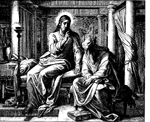Echoes
When it was evening, after sunset,
they brought to him all who were ill
or possessed by demons.
The whole town was gathered at the door.
He cured many who were sick with various diseases,
and he drove out many demons,
not permitting them to speak because they knew him.
Rising very early before dawn,
he left and went off to a deserted place,
where he prayed.
Mark 1:32-35
This scene from today's Gospel (Mark 1:29-39) was echoed in J.R.R. Tolkien's The Return of the King - the third volume of The Lord of the Rings:
"At the doors of the Houses many were already gathered to see Aragorn, and they followed after him; and when at last he had supped, men came and prayed that he would heal their kinsmen or their friends whose lives were in peril through hurt or wound, or who lay under the Black Shadow. And Aragorn arose and went out, and... laboured far into the night. And word went through the City: ' The King is come again indeed....'
"And when he could labour no more, he cast his cloak about him, and slipped out of the City, and went to his tent just ere dawn and slept for a little."
J.R.R. Tolkien, The Return of the King, p. 147.
The identification of a kingly figure as a healer is set up by Tolkien earlier in the chapter.
"'"The hands of the king are the hands of a healer." And so the rightful king could ever be known.'"
Ibid, p.136
This likewise echoes another Gospel scene:
"John (the Baptist) summoned two of his disciples
and sent them to the Lord to ask,
'Are you the one who is to come,
or should we look for another?'
"....And (Jesus) said to them in reply,
'Go and tell John what you have seen and heard:
the blind regain their sight, the lame walk,
lepers are cleansed, the deaf hear..."
Luke 7:18a-19,22a
The Lord of the Rings is not an allegory (a genre Tolkien "cordially" disliked), but Tolkien encouraged readers to explore the "applicability" of what he wrote. He also once described The Lord of the Rings as a "Catholic" work.
Thus readers have seen Christ-like qualities not only in Aragorn (as above), but also in Frodo (the suffering one upon whom the salvation of the world depends) and Gandalf (resurrection).
(Many such nuances, unfortunately, were lost in the recent Lord of the Rings films.)
The most important echoes of this Gospel, however, are not literary echoes in famous books - no matter how wonderful the books may be.
The most important echoes of this Gospel, in which the Lord labors long and hard to bring healing, should be found in our own lives: by our laboring long and hard to bring true healing by the grace of Christ.
Then will the rightful faith be known.
they brought to him all who were ill
or possessed by demons.
The whole town was gathered at the door.
He cured many who were sick with various diseases,
and he drove out many demons,
not permitting them to speak because they knew him.
Rising very early before dawn,
he left and went off to a deserted place,
where he prayed.
Mark 1:32-35
This scene from today's Gospel (Mark 1:29-39) was echoed in J.R.R. Tolkien's The Return of the King - the third volume of The Lord of the Rings:
"At the doors of the Houses many were already gathered to see Aragorn, and they followed after him; and when at last he had supped, men came and prayed that he would heal their kinsmen or their friends whose lives were in peril through hurt or wound, or who lay under the Black Shadow. And Aragorn arose and went out, and... laboured far into the night. And word went through the City: ' The King is come again indeed....'
"And when he could labour no more, he cast his cloak about him, and slipped out of the City, and went to his tent just ere dawn and slept for a little."
J.R.R. Tolkien, The Return of the King, p. 147.
The identification of a kingly figure as a healer is set up by Tolkien earlier in the chapter.
"'"The hands of the king are the hands of a healer." And so the rightful king could ever be known.'"
Ibid, p.136
This likewise echoes another Gospel scene:
"John (the Baptist) summoned two of his disciples
and sent them to the Lord to ask,
'Are you the one who is to come,
or should we look for another?'
"....And (Jesus) said to them in reply,
'Go and tell John what you have seen and heard:
the blind regain their sight, the lame walk,
lepers are cleansed, the deaf hear..."
Luke 7:18a-19,22a
The Lord of the Rings is not an allegory (a genre Tolkien "cordially" disliked), but Tolkien encouraged readers to explore the "applicability" of what he wrote. He also once described The Lord of the Rings as a "Catholic" work.
Thus readers have seen Christ-like qualities not only in Aragorn (as above), but also in Frodo (the suffering one upon whom the salvation of the world depends) and Gandalf (resurrection).
(Many such nuances, unfortunately, were lost in the recent Lord of the Rings films.)
The most important echoes of this Gospel, however, are not literary echoes in famous books - no matter how wonderful the books may be.
The most important echoes of this Gospel, in which the Lord labors long and hard to bring healing, should be found in our own lives: by our laboring long and hard to bring true healing by the grace of Christ.
Then will the rightful faith be known.
 A Penitent Blogger
A Penitent Blogger

<< Home